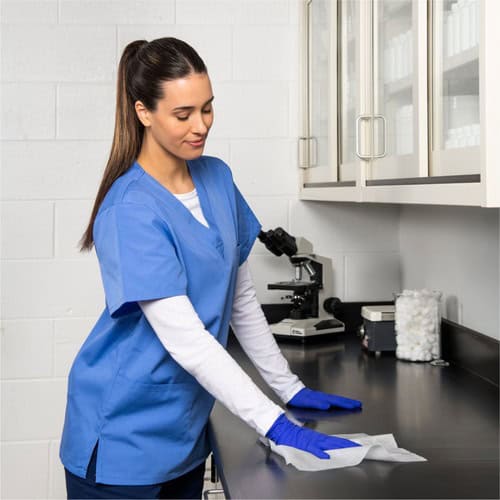
General disinfecting
Not all disinfectants are the same. In the United States and Canada, you’ll find more than 8,000 registered disinfectant products for sale, and there are several variations between them. Among the six most common chemistries used for disinfection, you’ll find vast differences in the spectrum of what pathogens they can kill, what the contact times are, what the personal safety levels of the product are, whether pre-cleaning is required as well as the personal protection needed for safe and proper usage.
CLEANING is the physical removal of foreign material and organic material. Cleaning physically removes rather than kills microorganisms. It is accomplished with water, detergents, and mechanical action.
SANITIZING lowers the numbers of germs on surfaces or objects to a safe level, as judged by public health standards or requirements. This process works by either cleaning or disinfecting surfaces to lower the risk of spreading infection.
DISINFECTING is the inactivation of disease-producing microorganisms including bacteria, viruses and fungi. Disinfection does not destroy bacterial spores.
STERILIZING is the level of reprocessing required when processing critical medical equipment/devices (equipment or devices that enter sterile tissue). Sterilization results in the destruction of all forms of microbial life including bacteria, viruses, spores and fungi.
Surface Must Be Wet to Disinfect. All disinfectants have a specific contact time on the label that must be followed. The contact time is the amount of the time the surface must remain wet for disinfection to be achieved. Contact times can range anywhere from 30 seconds to 10 minutes (longer contact times means you may have to re-apply the product more than once due to evaporation) You must always read the product label before use.
No. Products that make this claim leave behind active residues, however the surface needs to be wet for those active residues to continue to disinfect. These products leave behind residues because they don’t readily degrade, but rather build up in the environment.

Citr-IQ
Citr-IQ™ is a synergistic blend of ingredients that effectively kills pathogens using one of nature’s primary antimicrobials, citric acid, while remaining gentle on users, materials, and the environment.
At Virox, our innovations are leaving a safer planet for future generations. Our newest disinfectant technology uses citric acid derived from a natural and sustainable fermentation process to powerfully kill pathogens.
Citr-IQ™ is a patented disinfectant technology platform developed by Virox. At its core, it is a synergistic blend of ingredients that effectively kills pathogens using one of nature’s primary antimicrobials, citric acid, while remaining gentle on users, materials, and the environment.
Citr-IQ™ formulations are virucidal, bactericidal, fungicidal and tuberculocidal with proven efficacy against pathogens of concern, including ESBLs, Norovirus, Candida auris as well as SARS-CoV2. Ready-to-use Citr-IQ formulas, including disinfectant wipes, will achieve disinfection with a contact time of ≤1-minute. Dilutable Citr-IQ solutions are anticipated to achieve disinfection in 3-5 minutes at very high dilutions.
While citric acid is one of nature primary antimicrobials, current citric-acid based disinfectants are not as effective as Citr-IQ™. Virox has enhanced the safe and natural disinfecting properties of citric acid with a synergistic blend of ingredients to outperform other hospital grade disinfectants on the market. Citr-IQ’s synergistic chemistry is powerful enough to eliminate pathogens of concern quickly and effectively and it is the first citric acid-based tuberculocidal disinfectant with a contact time of ≤1-minute.
Citr-IQ™ has excellent compatibility with most materials including plastics and soft metals and has superior compatibility compared to quat alcohols, bleach, and even hydrogen peroxide-based products. See Citr-IQ’s full list of compatible materials.
Citr-IQ™ formulations use citric acid derived from a natural and sustainable fermentation process to powerfully kill pathogens. The ingredients in Citr-IQ are biodegradable and non-toxic, having no negative impact on the environment. Its superior compatibility also allows for more eco-friendly material and packaging options.
Professionals can anticipate wipe and ready-to-use products powered by Virox’s new technology, Citr-IQ™, starting in 2024 in Canada. Availability in the US and other regions will follow along with additional formats and formulations.

Accelerated Hydrogen Peroxide
Powerful disinfectants are easy to formulate. However, they are often toxic. We responded to this challenge with a unique and innovative chemical synergy that led to the development of Accelerated Hydrogen Peroxide®. AHP® is a synergistic blend of commonly used, safe ingredients that, when combined with low levels of hydrogen peroxide, produces exceptional potency as a germicide and performance as a cleaner.
AHP® is a patented synergistic blend of commonly used, safe ingredients that when combined with low levels of hydrogen peroxide dramatically increase its germicidal potency and cleaning performance. AHP® is composed of Hydrogen Peroxide, Surface Acting Agents (surfactants), wetting agents (a substance that reduces the surface tension of a liquid, causing the liquid to spread across or penetrate more easily the surface of a solid) and chelating agents (a substance that helps to reduce metal content and/or hardness of water).
Hydrogen peroxide, which you purchase at a local drugstore, is 3% Hydrogen Peroxide and 97% water making it very unstable and extremely easy to inactivate, which makes it unsuitable for use as a disinfectant on hard non-porous surfaces. To resolve this, a team of scientists took Hydrogen Peroxide and created a special formulation by adding chelating agents to help stabilize the hydrogen peroxide. This in turn allows it to accelerate the time it takes to disinfect a surface and remain active, for the length of time required to disinfect. This new highly effective Hydrogen Peroxide based technology is now called Accelerated Hydrogen Peroxide® (AHP®). Additionally, AHP® contains surfactants (detergents) and wetting agents, which reduce the surface tension of the liquid, and allow it to spread across or penetrate the surface more easily.
AHP can be used on all surface types if label instructions are followed. Surfaces that are composed of brass or copper or other non-ferrous metals may show signs of discoloration or pitting with use.
Yes, AHP products are effective for cleaning blood and body fluids. Excess blood and fluid must be removed with an absorbent material. The surface should then be cleaned using AHP by applying the solution and allowing a 30 second contact time to elapse. The surface should then be wiped dry. To disinfect the surface, AHP should be applied a second time, allowing the surface to remain wet for 5 minutes. Once the 5 minute contact time has passed the surface should be wiped dry or rinsed. All disinfectant products have a specific contact time by which their claims have been established. Failing to follow the Use Instructions and maintaining the proper contact time can mean that the surface in question has not been disinfected.
Reach Out
Contact UsWe pride ourselves on our entrepreneurial spirit and dedication to developing innovative solutions within the disinfectant space. Get in touch to learn how our products can match your needs.
